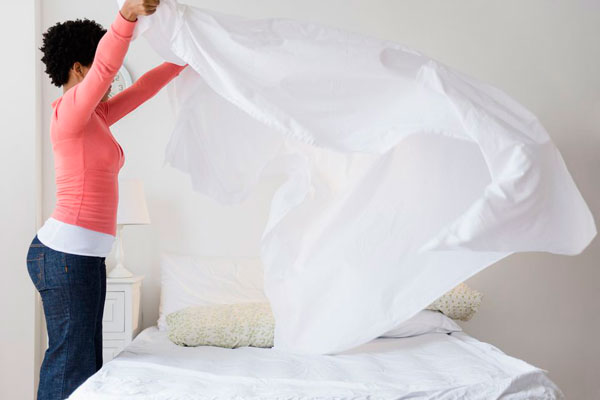How Often Should You Wash Or Change Your Sheets? Laundry & Cleaning Experts Answer

Generally, washing the bed sheets is not everyone’s favourite chore! In fact, almost three fifths of us don’t change our bed sheets each week, research from cleaning firm End of Tenancy Cleaning London has revealed.
Well, according to experts you should be changing your sheets every seven days—at minimum.
How Often Should You Wash Your Sheets?
“Bed sheets should be washed at least once a week or more, depending on how much body oil, dirt and sweat you leave behind each night,” says Mary Gagliardi, Clorox’s in-house laundry and cleaning expert.
“Think of your bedding like clothing. You are essentially ‘wearing’ it for eight hours every night.”
Just like your clothes, your sheets get grimy from sweat, drool (hey, it happens) and other bodily fluids. But there’s another unseen culprit: dead skin cells.
According to the American Academy of Dermatology, we shed 30,000 to 40,000 skin cells every day. Many of which linger in your bed long after you’ve gotten up to make coffee.
These dead skin cells invite dust mites to feed on them and those teeny bugs flourish in warm, humid settings—just like your cozy bed.
“Your body sheds approximately two teaspoons of dead skin [each night], which the dust mites consume. They do not transmit diseases but their poo has enzymes that can cause allergies or asthma,” explains Harriet Jones, cleaning and maintenance supervisor for Go Cleaners London, a U.K.-based cleaning company.
In addition to dust mites and their poop (yuck!), Dr. Janet Kennedy, a sleep specialist for direct-to-consumer online mattress company Leesa, says that bedding can accumulate other allergens like pet dander and pollen, all of which can cause congestion and other allergic reactions. She explains:
“Congestion can lead to snoring, which affects sleep quality (and relationships). Furthermore, a clean bed just feels good and that helps us to relax and settle into a good night’s sleep.”
Along with skin cells, your body also releases moisture, which can lead to a rather gross problem. Jones says:
“You may not notice during sleep, but [your] sweat creates a humid environment, which is the perfect habitat for fungi and bacteria to thrive.”
And if your pup shares your bed with you, beware because Jones says they’re basically just adorable vessels for germs. She notes:
“Walking around, sniffing anywhere and getting in contact with other dogs makes them one of the biggest bacteria providers into your home. If your dog is sleeping next to you, put him on a different blanket and wash it as often as possible.”
SEE ALSO: 6 Simple Tips To Keep Your Home Always Clean & Tidy
How to wash your sheets
The major key to effectively washing your sheets? Heat Jones suggests tossing your bed linens into hot water—140°F and above, if possible—in order to kill bacteria. But you might want to check the care label first.
White and light-colored cotton sheets can be washed in any water temperature while darker colored sheets should be washed in cooler H20 to prevent fading. But if you want to sanitize your sheets, especially if you’ve been sick or need to reduce allergens, it’s best to use your washing machine’s warm or hot cycle.
Keep in mind that high dryer temps can cause your sheets to wrinkle and shrink and it can also weaken fibers.
What about bleach? Well, Gagliardi says to consider the fiber content and colorfastness before you accidentally ruin your beautiful sheets.
Linens that are printed will often change colors upon contact with bleach, so conduct Gagliardi’s trusted test first: Add two teaspoons of bleach to a 1/4 cup of water.
Apply a drop of this mixture to a hidden part of the sheets (like the hem that gets tucked into the foot of the bed) and wait one minute.
Then rinse and blot dry. If there’s no color change, you can safely launder the sheets using detergent and bleach just like you would if they were white, Gagliardi says.
Sheets that don’t pass the test should be washed with detergent and a color-safe product like Clorox 2 For Colors, instead.
Don’t sleep with a top sheet separating you and your duvet? That’s nice. It also means you need to add an extra step to your laundry routine.
“If you’re one of the 40 percent of Americans who don’t use a top sheet, sleeping without one is not unsafe for your health as long as you still keep your bedding clean and comfortable,” says Karin Sun, founder of Crane & Canopy, an online provider of bedding, bath and home decor. “Just make sure to also wash your comforter or duvet cover weekly.”
And if you don’t have time to do laundry once a week, keep an additional set of sheets on hand so you can easily strip your bed and replace the dirty sheets with fresh ones.
How often should you wash your pillows?
Clean sheets won’t matter if your pillows are fluffed with grossness. Chassie Post, Mattress Firm’s lifestyle expert, recommends putting them through the washer every three to six months.
“Just as our pillows welcome our weary heads, they also welcome our dead skin cells, body oils and hair. This perfect storm provides a breeding ground for dust mites, which can prove particularly troublesome for allergy sufferers. Most pillows can simply be thrown in the washer, but make sure to follow the directions on the care tag (and don’t forget to add a few tennis balls in the dryer to keep them fluffy).
If you’ve washed your pillows a few times but still think they’re harboring grime, well, it might be time to replace them. Here are some other tell-tale signs that it’s time to invest in a new pillow:
1. You suffer from allergies.
You cough, sneeze and show signs of allergies at night, no matter how often you wash your pillows. This is probably due to a large buildup of dust mites.
2. You have a stiff neck.
You wake up with pain or stiffness in your neck. Naturally, our pillows lose their support and become flat over time.
3. It’s lost its shape.
Can your pillow be folded in half—and stay that way? That’s no good. Pillows are meant to spring back into place, so if it folds like a taco shell, you should probably just throw it out.
4. You’re experiencing breakouts.
You notice pimples or other skin issues on your face or neck (especially the side you sleep on). Your pillow could be carrying dirt, oil and other stains that do not come out in the wash.
5. It’s not comfy anymore.
Sometimes we struggle to get comfortable and fall asleep, and the quality of our bedding is to blame. If you’ve had trouble sleeping, take some time to notice and consider if your pillow is adding comfort or tension at night.
Source: GoodHouseKeeping .com


